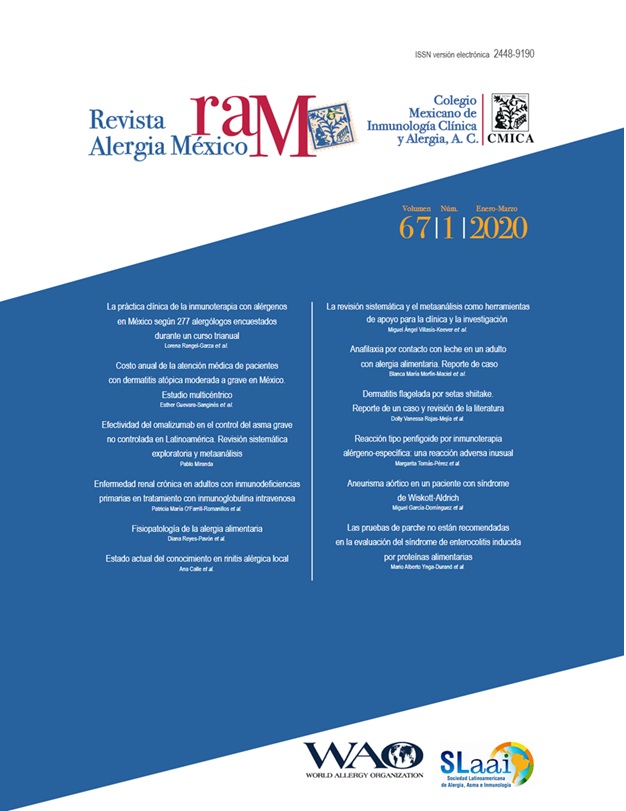Resumen
Antecedentes: Existen lineamientos para el diagnóstico de las enfermedades alérgicas y la aplicación de inmunoterapia con alérgenos (ITA).
Objetivo: Describir cómo los alergólogos mexicanos diagnostican y tratan con ITA las alergias alimentaria y respiratoria.
Métodos: Se encuestó a 227 alergólogos que acudieron a un simposio de inmunoterapia; se indagaron prácticas cotidianas en el diagnóstico de las alergias respiratoria y alimentaria, así como en la forma de aplicar la ITA.
Resultados: Los alergólogos utilizan las pruebas cutáneas por punción para el diagnóstico de las alergias respiratorias y alimentarias en 100 y 87.7 % de los casos de una y otra; diagnóstico in vitro mediante determinación de IgE alérgeno-específica en 55.5 y 63 %; y diagnóstico molecular por componentes en 14.1 y 13.2 %. Para los aeroalérgenos, 81 % emplea ITA subcutánea; 77.9 %, ITA sublingual líquida; 1.8 %, ITSL en tabletas; 45 % indicó que estaba dispuesto a emplear tabletas en el futuro. Para los alérgenos de alimentos, la mayoría no utilizaba ITA, aunque 55 % se interesa en la ITA oral y 59 %, en la ITA sublingual.
Conclusiones: En términos generales, el diagnóstico y tratamiento de las enfermedades alérgicas se realizan conforme los lineamientos internacionales, además, los alergólogos encuestados mostraron flexibilidad para adoptar nuevos esquemas.
Referencias
Noon L. Prophylactic inoculation against hay fever. Int Arch Appl Immunol. 1953;4(4):285-288. DOI: 10.1159/000228032
Freeman J. Further observations of the treatment of hay fever by hypodermic inoculations of pollen vaccine. Lancet. 1911;2:814-817
Heinzerling L, Mari A, Bergmann KC, Bresciani M, Burbach G, Darsow U, et al. The skin prick test-European standards. Clin Transl Allergy. 2013;3(1):3. DOI: 10.1186/2045-7022-3-3
Cox L, Nelson H, Lockey R, Calabria C, Chacko T, Finegold I, et al. Allergen immunotherapy: a practice parameter third update. J Allergy Clin Immunol. 2011;127(Suppl1):S1-S55. DOI: 10.1016/j.jaci.2010.09.034
Bousquet J, Lockey R, Malling HJ. Allergen immunotherapy: therapeutic vaccines or allergic diseases. A WHO position paper. J Allergy Clin Immunol. 1998;102(4 Pt 1):558-562. DOI: 10.1016/s0091-6749(98)70271-4
Pedroza A, Becerril M. Consenso nacional de inmunoterapia. Rev Alerg Mex. 1998;45(Supl May).
Larenas-Linnemann D, Ortega-Martell JA, Del Río-Navarro B, Rodríguez-Pérez N, Arias-Cruz A, Estrada A, et al. Guía Mexicana de Práctica Clínica de Inmunoterapia 2011. Rev Alerg Mex. 2011;58(1):3-75. Disponible en: https://www.elsevier.es/es-revista-revista-alergia-mexico-336-articulo-guia-mexicana-practica-clinica-inmunoterapia-X0002515111209882
Larenas-Linnemann D, Luna Pech JA, Rodríguez-Pérez N, Rodríguez-González M, Arias-Cruz A, Blandón-Vijil MV, et al. GUIMIT 2019, Guía Mexicana de Inmunoterapia. Guía de diagnóstico de alergia mediada por IgE e inmunoterapia aplicando el método ADAPTE. Rev Alerg Mex. 2019;66(Supl 1):1-105. DOI: 10.29262/ram.v66i5.631
Frankland AW, Augustin R. Prophylaxis of summer hay-fever and asthma: a controlled trial comparing crude grass-pollen extracts with the isolated main protein component. Lancet. 1954;266(6821):1055-1057.
Amin HS, Liss GM, Bernstein DI. Evaluation of near-fatal reactions to allergen immunotherapy injections. J Allergy Clin Immunol. 2006;117(1):169-175. DOI: 10.1016/j.jaci.2005.10.010
Larenas-Linnemann D, Rodríguez-Pérez N, Becerril M. Adverse reactions to skin tests and immunotherapy in the practice of Mexican allergologists. Rev Alerg Mex. 2008;55(2):62-70.
González-Diaz S, de la Rosa-López JH, Arias Cruz A, Macías-Weinmann A, Herrera-Castro D, Rodríguez-Ortiz P, et al. Reacciones sistémicas relacionadas a la inmunoterapia con alérgenos en Monterrey, México. Rev Alerg Mex. 2011;58(2):79-86. Disponible en: https://www.elsevier.es/es-revista-revista-alergia-mexico-336-articulo-reacciones-sistemicas-relacionadas-inmunoterapia-con-X0002515111240634
Rodríguez-Pérez N, Ambriz-Moreno MJ, Pizarro-Esquivel U. Reacciones sistémicas no fatales por inmunoterapia y pruebas cutáneas. Rev Alergia Mex. 2002;49(3):69-73.
Larenas-Linnemann D, Luna-Pech JA, Mösges R. Debates in allergy medicine: allergy skin testing cannot be replaced by molecular diagnosis in the near future. World Allergy Organ J. 2017;10(1):32. DOI: 10.1186/s40413-017-0164-1
Bernstein IL, Li JT, Bernstein DI, Hamilton R, Spector SL, Tan R, et al. Allergy diagnostic testing: an updated practice parameter. Ann Allergy Asthma Immunol. 2008;100(3 Suppl 3):S1-S148. DOI: 10.1016/s1081-1206(10)60305-5
Lockey RF, Benedict LM, Turkeltaub PC, Bukantz SC. Fatalities from immunotherapy (IT) and skin testing (ST). J Allergy Clin Immunol. 1987;79(4):660-677. DOI: 10.1016/s0091-6749(87)80164-1
Wollenberg A, Vogel S. Patch testing for noncontact dermatitis: the atopy patch test for food and inhalants. Curr Allergy Asthma Rep. 2013;13(5):539-544. DOI: 10.1007/s11882-013-0368-6
Luo, Y, Zhang, GQ, Li, ZY. The diagnostic value of APT for food allergy in children: a systematic review and meta-analysis. Pediatr Allergy Immunol. 2019;30(4):1-11. DOI: 10.1111/pai.13031
Breiteneder H, Hassfeld W, Pettenburger K, Jarolim E, Breitenbach M, Rumpold H, et al. Isolation and characterization of messenger RNA from male inflorescences and pollen of the white birch (Betula verrucosa). Int Arch Allergy Appl Immunol. 1988;87(1):19-24. DOI: 10.1159/000234643
Canonica GW, Ansotegui IJ, Pawankar R, et al. A WAO-ARIA-GA²LEN consensus document on molecular-based allergy diagnostics. World Allergy Organ J. 2013;6(1):1-17. DOI: 10.1186/1939-4551-6-17
Becker S, Gröger M, Jakob T, Klimek L. The benefit of molecular diagnostics in allergic rhinitis. Allerg J Int. 2017;26(Suppl 23):301-310. DOI: 10.1007/s40629-017-0033-z
Mosbech H, Deckelmann R, de Blay F, Pastorello EA, Trebas-Pietras E, Malcus I, et al. Standardized quality (SQ) house dust mite sublingual immunotherapy tablet (ALK) reduces inhaled corticosteroid use while maintaining asthma control: A randomized, double-blind, placebo-controlled trial. J Allergy Clin Immunol. 2014;134(3):568-575. DOI: 10.1016/j.jaci.2014.03.019
Li Y, Yu SY, Tang R, Zhao ZT, Sun JL. Sublingual immunotherapy tablets relieve symptoms in adults with allergic rhinitis: a meta-analysis of randomized clinical trials. Chin Med J (Engl). 2018;131(21):2583-2588. DOI: 10.4103/0366-6999.244108
Martínez-Gómez JM, Johansen P, Erdmann I, Senti G, Crameri R, Kündig T. Intralymphatic injections as a new administration route for allergen-specific immunotherapy. Int Arch Allergy Immunol. 2009;150(1):59-65. DOI: 10.1159/000210381
Senti G, Kündig TM. Novel delivery routes for allergy immunotherapy: Intralymphatic, epicutaneous, and intradermal. Immunol Allergy Clin North Am. 2016;36(1):25-37. DOI: 10.1016/j.iac.2015.08.006
Sicherer SH, Sampson HA. Food allergy: epidemiology, pathogenesis, diagnosis, and treatment. J. Allergy Clin Immunol. 2014;133(2):291-307. DOI: 10.1016/j.jaci.2013.11.020

Esta obra está bajo una licencia internacional Creative Commons Atribución-NoComercial 4.0.
Derechos de autor 2020 Revista Alergia México

